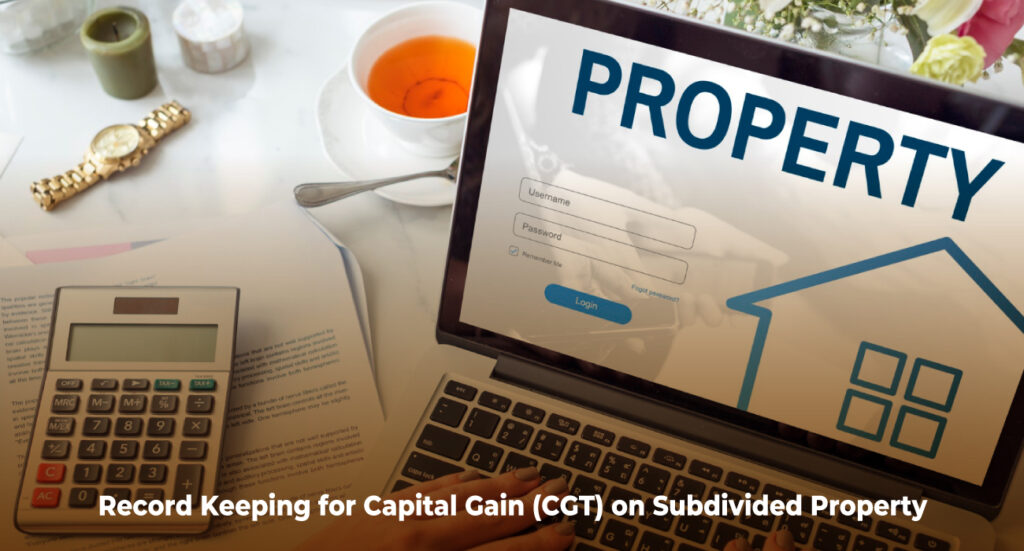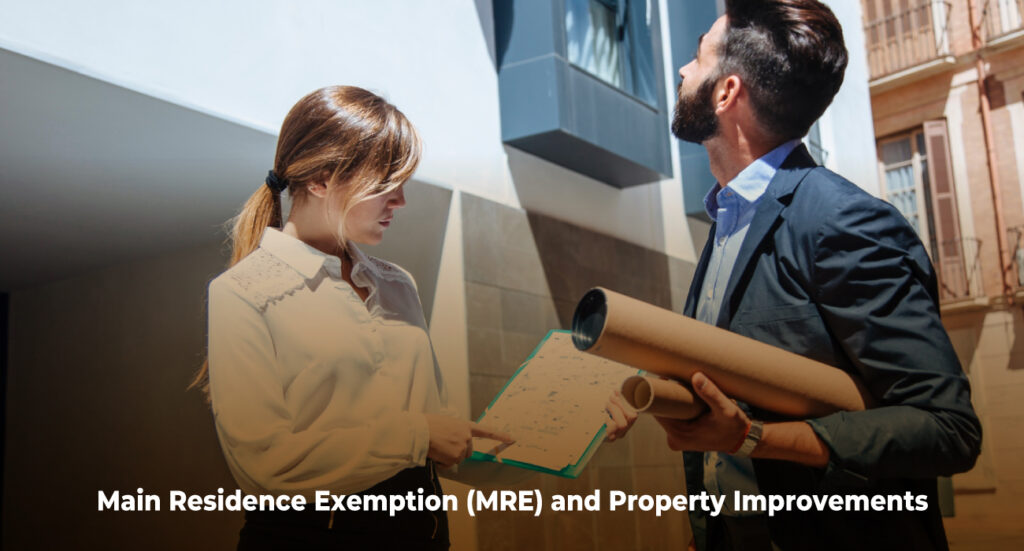Capital Gain (CGT) on Property Subdivision: A Guide for Property Investors
Capital Gains Tax (CGT) remains one of the most popular topics among property investors, and for good reason. Many assume it’s simply the difference between buying and selling an asset, but the reality is far more complex. The calculation involves multiple factors such as acquisition costs, ownership structures, and timing. When subdivision enters the picture, the complexity often multiplies. From apportioning the cost base between the original and subdivided lots to navigating ATO rules, even a small misstep can lead to unexpected tax bills.
In this article, we will try to de-mystify capital gains, what record keeping you need, and everything about subdivision.

Record Keeping for Capital Gain (CGT) on Subdivided Property
Many taxpayers and property investors believe that once they sell a property and declare their capital gain, their job is finished. Unfortunately, that’s far from the truth. When new clients join us and we request copies of their purchase contracts and settlement statements, we often find they struggle to locate these documents—and sometimes even question why we ask for so many details. What many don’t realise is that we request these records for their own benefit.
For CGT purposes, the ATO requires property owners to keep records for at least 5 years after disposing of a property. These records include:
- Acquisition documents and related costs (e.g., stamp duty, legal fees)
- Disposal documents and related costs (e.g., agent commission, legal fees)
- Ownership costs
- Improvements and alterations made to the property
Understanding the Cost Base for Capital Gain (CGT)
Anyone who tries to understand capital gain must first understand the concept of the cost base. The cost base is more than just the purchase price of a property—it includes expenses such as stamp duty, legal fees, loan establishment costs, and even certain holding costs in some circumstances. For property investors undertaking a subdivision, correctly apportioning the cost base between the original and new lots is essential. Getting this wrong can significantly inflate your CGT liability, so accurate record keeping and professional advice are key.

How Subdivision and Mergers Affect Your Capital Gain (CGT) Cost Base
When it comes to CGT, subdividing land doesn’t trigger an immediate tax event. Instead, it simply means one block of land becomes two or more separate CGT assets. The important part is that when you eventually sell, the CGT is calculated for each new block based on the original purchase date of the land.
The cost base of the original land must be divided between the new blocks in a fair and reasonable way. As explained in Taxation Determination TD 97/3, each subdivided block is treated as a separate asset with its own CGT calculation once sold.
Similarly, if you merge two or more blocks into one title, this also doesn’t create a CGT event. The cost base of the new merged block is simply the total of the cost bases of the individual blocks.
Note – Relevant guidance is provided by Taxation Determination TD 97/3
Capital Gain (CGT) on Subdividing a Main Residence
Subdividing your main residence can create unexpected tax consequences. If you subdivide the land and sell the vacant block on its own, the main residence exemption (MRE) will not apply to that block, even if it was always used privately. This is because once sold separately, the vacant land is treated as its own CGT asset.
However, under the adjacent land rule (section 118-120 ITAA 1997), you may be able to extend the MRE to land surrounding your home—up to two hectares—if it was used mainly for private or domestic purposes. To qualify, the adjacent land must be sold together with the dwelling in the same transaction, to the same buyer. In that case, both the home and the adjacent land may be exempt.
The key takeaway: sell the house and land together to benefit from the exemption; sell the vacant land separately and CGT will likely apply.

Buying and Subdividing for Profit – Is It Treated as Capital Gain (CGT)?
Many property investors assume that any gain from buying and subdividing land will always fall under Capital Gains Tax (CGT). However, this isn’t always the case. If the main purpose of the purchase and subdivision is to make a profit, the ATO may treat it as a business activity. In that situation, the profit is taxed as ordinary income, not as a capital gain. This means you could lose access to concessions such as the 50% CGT discount.
The ATO’s Taxation Ruling TR 92/3 explains when profits from isolated transactions are considered ordinary income. In simple terms:
- If you are already in business and the transaction is part of your usual activities, any profit is treated as income.
- If the transaction is outside your normal business but was entered into with the clear intention of making a profit, it can still be taxed as income.
- Even if you’re not carrying on a business, profits may still be taxed as income if the deal was a commercial operation with a profit-making purpose.
In short, if you buy land with the intention of subdividing and selling for a quick profit, the ATO is likely to treat it as income rather than a capital gain. Getting the classification wrong can result in a nasty surprise at tax time, so it’s essential to plan carefully and seek professional advice.
Pre-CGT Asset Improvements and Capital Gains Tax (CGT)
The acquisition date of your property is key for Capital Gains Tax (CGT). Properties bought before 20 September 1985are pre-CGT assets, meaning the property itself is exempt. However, major improvements made after that date are treated as separate CGT assets and may be taxable when you sell.
For properties purchased on or after 20 September 1985, both the land and improvements are combined into the cost base, and CGT is calculated in the usual way.
Example: Suppose you bought your home in 1984. In 2020, you build a granny flat at the back. The original home stays CGT-exempt, but the granny flat is a post-CGT improvement. When the property is sold, you’ll need to calculate CGT on the granny flat portion, even though the main dwelling remains exempt.

Main Residence Exemption (MRE) and Property Improvements
The main residence exemption (MRE) is a rule that helps you avoid paying Capital Gains Tax (CGT) when you sell your family home. It doesn’t just cover the house itself—it can also cover improvements you make to the home, like renovations or extensions.
The exemption can also extend to land around your home, such as your yard, garden, or even a garage built on the same block. However, there is a limit: the total area of the property, including the land and the home, can’t be more than two hectares (about five acres).
However, the exemption does not apply if the improvements are used to generate income. For example:
- Renting out a room in your home through Airbnb
- Building a shed at the back and leasing it to your own business
- Adding a studio in the garage to run a podcast or other income-producing activities
In these cases, the ATO may treat the improvement (or part of it) as income-producing, which reduces your MRE entitlement. That means a portion of the capital gain could become taxable when you eventually sell the property.
Example: Suppose you build a granny flat on your main residence land and rent it out. While your home may still qualify for the MRE, the granny flat is considered income-producing, so capital gains on that portion will not be exempt.
What’s Next
Subdividing property and understanding the Capital Gains Tax (CGT) implications can be tricky. From cost base rules to main residence exemptions, pre-CGT assets, and income-producing improvements, every decision you make can affect your tax outcome. Getting it wrong could mean paying more tax than you should, while the right planning can save you thousands.
At Investax, we specialise in helping property investors navigate complex CGT rules with confidence. An accounting fee paid to a good accountant should be seen as an investment—not a cost. Especially when that fee is 100% tax deductible, it makes sense to work with someone who understands the complexity of property tax.
Reference:
ATO – Record Keeping
Taxation Determination TD 97/3,
Taxation Ruling TR 92/3
General Advice Warning
The material on this page and on this website has been prepared for general information purposes only and not as specific advice to any particular person. Any advice contained on this page and on this website is General Advice and does not take into account any person’s particular investment objectives, financial situation and particular needs.
Before making an investment decision based on this advice you should consider, with or without the assistance of a securities adviser, whether it is appropriate to your particular investment needs, objectives and financial circumstances. In addition, the examples provided on this page and on this website are for illustrative purposes only.
Although every effort has been made to verify the accuracy of the information contained on this page and on our website, Investax Group, its officers, representatives, employees and agents disclaim all liability [except for any liability which by law cannot be excluded), for any error, inaccuracy in, or omission from the information contained in this website or any loss or damage suffered by any person directly or indirectly through relying on this information.





